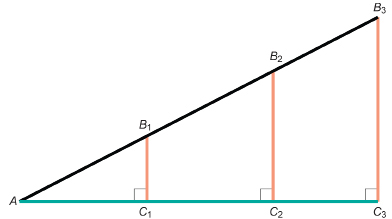Module 7
1. Module 7
1.13. Page 3
Module 7: Trigonometry
Explore
In the previous two lessons you explored the ratio of the side opposite to the side adjacent to a given acute angle in a right triangle. You discovered that this ratio, called the tangent ratio, is the same value in right triangles that are similar. It does not matter how large or small the right triangles are! For a particular angle, such as 20°, this ratio is fixed. So, if you know the angle, you can determine the ratio. And, if you know the ratio, you can determine the angle.
 Try This
Try This
In this activity you will explore another trigonometric ratio involving a different pair of sides within a right triangle. You will compare this ratio with ratios involving the same pair of sides from other right triangles. For this comparison you will use the skills for similar right triangles you mastered in Module 6.
You will need your ruler, a protractor or square, and a calculator. Work with a partner, if possible.
Consider the right triangles in the following diagram.

Step 1: Draw a similar diagram to work with.
Step 2: For right triangle AB1C1, measure to the nearest millimetre and record the length of sides B1C1 and AB1.
For right triangle AB2C2, measure to the nearest millimetre and record the length of sides B2C2 and AB2.
For right triangle AB3C3, measure to the nearest millimetre and record the length of sides B3C3 and AB3.
Step 3: Complete the following table. Then answer the Try This questions.
|
Right Triangle |
Side Opposite ∠A (nearest mm) |
Hypotenuse |
side opposite hypotenuse (2 decimal places) |
|
ΔAB1C1 |
B1C1= |
AB1= |
|
|
ΔAB2C2 |
B2C2= |
AB2= |
|
|
ΔAB3C3 |
B3C3= |
AB3= |
|
TT 1. Explain why ΔAB1C1, ΔAB2C2, and ΔAB3C3 are similar triangles.
TT 2. Because the triangles are similar, the ratio ![]() you calculated should be the same for each triangle. The following statements prove these ratios for ΔAB1C1 and ΔAB3C3 are equal. Supply a reason for each step in the proof.
you calculated should be the same for each triangle. The following statements prove these ratios for ΔAB1C1 and ΔAB3C3 are equal. Supply a reason for each step in the proof.
|
Statement |
Reason |
|
|
|
|
B2C2 × AB1 = B1C1 × AB2 |
|
|
Therefore, |
|
 Share
Share
Share your answers from the Step 3 table with as many other students as possible. You may find that the ratios for your triangles were different from the ratios other students obtained. Why might this be? Measure the ∠A in your triangles, and compare this angle measurement with other students. Can you identify a pattern between the ratio ![]() calculated for the different angle measures?
calculated for the different angle measures?
Summarize the patterns you noticed during this sharing session, and save a copy in your course folder.